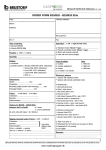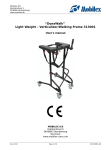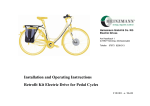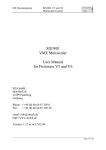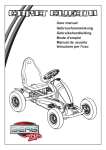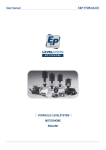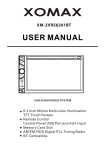Download Toogether - Handicare AS
Transcript
Toogether USER MANUAL SERVICE MANUAL 0 - page index Foreword 2 Putting into use 3 Points for attention 3 Maintenance 3 The tyres 3 The chain 3 The handles 4 The gears 4 Handlebars 4 The lighting 5 The lock 5 The seat 5 The collapsible armsupport 5 The brakes 6 The mirror 6 The cane holder 6 The electric drive set 7 -14 Technical specifications 15 Warranty 16 Warrentycard 16 Finally 16 Symbols used Important information for your safety is marked by special symbols. Please follow this information to avoid injury and damage to the product. WARNING: This symbol warns of hazards to your health and points to potential risks of injury. CAUTION: This symbol points to potential risks to the product or other items of property. Note: This symbol indicates tips and special information. 1 Foreword This bike is a technologically high-quality product. He will give you "the support in the back" that you need. This bike a little bit difference as any other "regular bike", we recommend that you read this manual carefully, to ensure your safety. We wish you many years of enjoyment with your Nijland Cycling bike and you will see that the pleasure is even greater, when you have sufficient attention to the maintenance of your bike. Nijland Cycling Heeten 2 Tyres Putting into use The maintenance In the factory is already spent the necessary care to your bike and your dealer maked it cycle ready. The steering wheel and saddle are adjusted to the right size and the whole is checked again, so now your Toogether can go riding. Of course, it is necessary to If your tires are not at the maintain your bike properly: right pressure - too soft - they will wear out faster. The this extends the lifetime. pressure is correct if you’re Clean your bike regularly, for able to press the tire with your thumbs. If you have a example, once a month. Wipe the worst dirt away with pump with a pressure gauge, stick to the a not too stiff bristle or brush; please do this with policy to avoid recommended pressure listed scratches. Wipe off the last on the side of the tire. Hard are much more residue with a cloth tires enjoyable to ride also your (preferably a flannel rag) bike listens better to the brakes and steering. The weight of the retrofit kit and the extra motor power will have quite a significant impact on the performance of the bicycle. You must allow for longer stopping distances because of the increased weight. You should therefore CAUTION: Never practice the safe control of clean your bicycle with a high your electric bicycle off the pressure washer. The steam or waterjet can penetrate to public roads to start with. the inside of the bearings and You should perform a safety can remove the necessary check on the electric bicycle grease. before every trip to prevent accidents. You should have the bicycle's operating Good maintenance is not instructions to hand in case affected by cleaning alone. you need to make any Regular monitoring of vital adjustments to individual parts is very important. It is components of the particular recommended to let the dealer inspect your bike at model of bicycle. least twice a year. Points for attention • Make sure you are well seen. At light rainfall and fog you turn on your lights. • At a wet surface it is wise that you quietly inhibits Please in that case consider a longer stopping distance. • Be careful with slippery soles, you run the risk to shoot of the pedal. • For more safety you can use a bicycle helmet, which are for sale at your bikes-dealer. • For the Toogether are many accessories available which has a great contribution to safety when cycling. These accessories comes later in this manual against. When you don't use your bike for an extended period of time, make sure you put it in a dry, cool area. It is important that the tire pressure is low and the Toogether is thoroughly clean. 3 Chain A right tension of the chain is necessary in order to bring the rotating movement of the crankset to the rear wheel. If the chain is too loose, there is a change that it runs off the sprockets and run against the chain case. If it’s too tight, You should not only put unnecessary force, but, there is also risk of damage to the bottom bracket bearings, wheel bearings and sprockets. Handles Although we take extreme care to mount the handles and prevent them to sit 'Loose', it may occur that the handles come loose by the action of sunlight, temperature differences and age. You must regularly check that the handles are fixed by trying to twist them. If a handle has been disconnected from the handlebar it should never be used again. You should let your dealer install new handles. Handlebar Gears Note: If you want to adjust the handlebar height, the security marking should be not to see. The Toogether can be fitted with a Sram hub gear. By the grip shiftswitch to turn to you (see fig. 1), you can enable a lighter gear. This can come in handy if you cycle uphill or if there is a strong headwind condition. If you turn off grip shift switch you select a heavier gear For a proper sitting, you can also adjust the handlebar forward or backward and up or down to your own wishes. Up and down • • • Forward or backward • • • When switching, it is important don't exercise strength on the pedals. When you get the system keeps your feet are still for a moment, the system get the time to change between the gears. It is wise to let your dealer do the adjustment. You turn the hexagon screw of the stem (fig. 2A) a few turns counterclockwise. You adjust the handlebar at the right height. You turn the hexagon screw of the stem (fig. 2) firmly again. • Figure 1 A Figure 2 You turn the hexagon screw of the stem (fig. 3) a few turns counterclockwise. You adjust the handlebar at the right position. You turn the hexagon screw of the stem (fig. 3) firmly again. To perfect the handlebar position, you can repeat the previous steps B A Figure 3 4 lighting • If you already have lost a key, it's advisable to make a copy of the spare key. The Toogethers have a lighting form with Battery, consisting of batteries, headlight and rear light. The seat To turn on the headlight and rear light, press on the buttons that are on the light. The seat of the driver and passenger are separately adjustable. To turn off the lights, press on the same buttons. To Adjust the seat you have to lift the pin that is under your seat. If you lift the pen, you’re Lock able to slide de seat over the square tube. Then push the The safety lock is to operate in pin in one of the holes for the the following way: correct position. • Turn the key in the lock clockwise. • Push the sliding handle down, so that the lock the rear wheel locked. • Turn the key in the lock counterclockwise and remove the key from the lock. collapsible armsupport The seat of the Toogether can be performed with collapsible armsupport. These armsupport can be collapse up. If you sit down on the Toogether you will not suffer from the armsupport. Once on the bike then you flips this down. This gives you a comfortable armsupport when cycling. When you use the rear or front seat patched the armsupport are automatically entered (Fig. 5). You can un-lock the rear wheel to put the key in the lock and turn it clockwise. Figure 4 • Avoid theft and put your bike always locked. Even if you ' just ' are away. • Note the frame number of your bike. It is a small sticker placed on your bike. This number is also on the head sticker in front of your bike. • Let your post code engrave into your bicycle engraving by your dealer. Figure 5 CAUTION: Make sure that the pin under your seat is all the way into the hole. This ensures the safe use of your Toogether. 5 Brakes Mirror - The brakes belong to the most important parts of your bike. Whenever possible, use both brakes to slow down as dosed as possible. A rear-view mirror should be used to enhance your awareness of the traffic situation. • The mirror is adjustable by turning the plastic mirror box into the right position Always check the brakes • You can also adjust the mirror are working properly rod with the bolts (fig. 6B) before you ride. If you find forward or backward. Figure 7A (Activated parkingbrake) out that you almost have to pull the brake lever up to the handle, the brakes Cane holder needs readjustment You can use the cane holder by placing your canes or crutches in the bin (fig 8A). and lock The Toogether three- them with the Velcro wheelbicycles are provided with a parking brake instead of a bicycle stand. In situations where the Figure 7B (Deactivated parkingbrake) bike would not remain on the spot, you can use the parking brake. It’s shown activated in fig. 7A and deactivated in fig. 7B. Parking brake B CAUTION: Never grease your brake hubs and rims for any Figure 6 reason whatsoever with lubricants, this may decrease the effect tremendously. Figure 8 A 6 The Electric drive set Safety instructions Carefully read through all of these instructions before using the product! Keep these instructions in a safe place! If the product is passed on to a third party, the instructions must be passed on with it. Failure to follow these instructions may result in injury or damage to the components. The manufacturer can accept no liability for losses arising as a result of failure to follow these instructions. Starting up WARNING: The electric bicycle must not be operated if the twist grip's automatic return is faulty. The fault should be rectified by a specialist dealer. NOTE: Always check the twist grip's automatic return before starting up. The system must be switched off to start with! To check the automatic return, twist the twist grip backwards and release again (see Fig 9). CAUTION: A damaged motor can The twist grip must immediately result in the failure of return to its initial (zero) structural parts and will position. have to be replaced. The voltage supply for the electric drive must be switched on first of all. CAUTION: Damaged electrical This takes place on the control modules and cables can unit located under the luggage cause short circuits and carrier. must be replaced. Remove the protective cap from the lock on the control unit. Intended use The drive set in only used for equipping a bicycle as Place the key in the lock and an electric bicycle. No switch to "on" (Fig. 10). other use is permitted. Take the key out again so it cannot get lost during the journey. Replace the protective cap on the lock. First mount the electric bicycle. 7 Figure 9 Figure 10 Only then should the control be switched on. To do this, press the button on the twist grip for longer than 1 second (Fig. 11). All three LEDs light up when the button is pressed. Release the button when all LEDs light up continuously. The control Figure 11 is now switched on and the drive system is ready for Cycling use. To deactivate the control while you are riding, e.g. if you wish to just pedal the cycle without any motor assistance or during long rides on the level or downhill, proceed as follows: • Gently turn the twist grip forwards to its zero position • Press the button on the twist grip for at least 1 second until all the LEDs go out. The control is now switched off. WARNING: You should never block or obstruct the twist grip's NOTE: The need to press and automatic return while riding the NOTE: hold the button is a safety electric bicycle! The control shuts off measure to prevent automatically when: accidental switching on or Once you are under way, to • the battery has reached the the assistance off. As a further safety increase deep discharge limit. feature, the drive can only provided by the motor and to • the motor or control unit be switched on when the continue accelerating, turn the overheat. This is possible, twist grip is in its zero twist grip more towards you e.g. after longer periods of while pedalling faster. position (front stop). up-hill travel or extended use with a second Pedal to start off, just as To reduce the assistance transported battery. After an with a conventional provided by the motor and appropriate cooling period bicycle. Add the power of reduce speed, slowly turn the (approx. 10 - 15 minutes), the motor according to twist grip forwards. the drive is ready for your own requirements by operation again. Before softly turning the twist grip. If your speed increases while continuing on a journey, the you are pedalling, you should drive system on the control change up to a higher gear. unit must be switched off You should change down to a and on again. lower gear if your speed NOTE: On the EPAC with assisted decreases (e.g. riding uphill). pull-away, the motor can The control unit turns the drive be put in gear without off if you pedal too slowly. pedalling by turning the twist grip. When the rider is not pedalling, the motor provides support up to a speed of 6 km/h. The assisted pull-away on the EPAC can also be used as a pushing aid. . 8 Ending the journey Twist grip functions Gently turn the twist grip forwards to its zero The following can be found on position (front stop). the twist grip (Fig.13) : • a button for switching the Using the front and rear control on and off brakes, bring the electric • three LEDs, green, yellow bicycle to a complete and red, to show the charge stop. status and any error reports. Switch off the control. Press the button on the twist grip for at least 1 second until all the LEDs go out. Switching on the control See Chapter "Starting up" Switching off the control See Chapter "Cycling" Remove the protective cap Indicators from the lock on the control The three LEDs provide unit. information on: - the battery power Switch off the voltage - the control status supply. Place the key in the lock on the control unit The three LEDs on the twist and switch to "off" (Fig.12) grip show the current battery voltage. Take the key out of the The indicator shows information lock if you are taking a on the charge status. longer break (this will prevent unauthorized use) and replace the protective cap on the lock. The actual charge state of the battery can only be read off the battery itself (see Chapter "Battery charging"). Figure 12 NOTE: If you forget to switch it off, the control switches off automatically after approx. 15 minutes if no cycling activity takes place. You must switch it on again with the button on the twist grip before further use. 9 Figure 13 Status of the control, errors and warnings: LED indicator LEDs flash quickly when switched on Error or warning Twist grip not in zero position when the control is switched on. Actions: Put the twist grip in zero position, check the twist grip's automatic return. LEDs flash slowly during use The motor or control overheat. Motor is switched off. Actions: Return the twist grip to zero position. Do not use the motor and control for a while and allow to cool down. The drive can then be used again with no further actions required. LEDs flash quickly during use and when switching off Battery voltage or control unit voltage too low. Motor is switched off. Actions: Charge the battery. You must switch the control on again with the button on the twist grip before further use. Other possible faults Fault Undervoltage on the battery or control unit Effect and actions Motor is switched off. Actions: Charge the battery. Switch the control off and on again with the button Short-circuit on the battery or battery completely discharged Motor, control and battery are switched off. Actions: Remove the short circuit. Charge the battery. You must switch the control on again with the button on the twist grip before further use. WARNING: If the measures outlined above are unsuccessful, consult a specialist dealer. Never open the control unit, the motor or the battery! 10 Battery Information on batteries The type of battery used in the drive set combines lightness in weight with a very high charge capacity. It is therefore very compact in design and will fit easily into the battery bag provided. Lithium-ion batteries may only be charged using a special charging circuit! The reasonable use and above all correct charging of the battery as well as protection from deep discharge and overheating will greatly help to prolong its life. An appropriate charge controller is therefore already integrated in the battery housing to ensure optimal and safe function. A mains adapter without its own charge controller is therefore all that is needed to charge the lithium-ion battery. WARNING: Use only the mains adapter supplied to charge the battery. Condensation water can develop on the mains adapter if there is a sudden change in temperature from cold to hot. If this happens, wait until the device has come up to the temperature of the warm room before connecting it to the mains. This situation is best avoided by storing the mains adapter where you use it. Before connecting the mains adapter to the mains, you must check whether the mains voltage matches the supply voltage of the adapter. The adapter's supply voltage is indicated on the nameplate on the back of the The mains adapter may only be adapter. The adapter is used to charge up the battery supplied. designed for indoor use only. Other uses of the adapter are The lithium-ion battery may only not permitted. be charged in a dry, non Any tampering of any kind with flammable environment. the mains adapter or battery box is strictly prohibited! Mechanical damage to the WARNING: A mains adapter with a battery must be avoided at all damaged mains plug or mains cost (explosion hazard!). lead must not be connected to the mains and must be repaired immediately by a specialist dealer. The same applies to extension cables that are not technically perfect. The mains adapter and the battery can get hot when charging lithium-ion batteries. The mains adapter should therefore be removed from the storage recess in the battery box during charging. Water and moisture must not be allowed to penetrate the mains adapter under any circumstances. If water has entered the adapter, disconnect it from the mains supply immediately and have it checked by a specialist dealer. 11 Battery charging All batteries usually leave the factory fully charged. However, because there is always a certain amount of self-discharge (typically ~1% per day at room temperature) the battery should be charged up before being used for the first time. To charge the battery, proceed as follows: • Gain access to the charging socket on the battery box by pushing the protective cover to the left (Fig. 15). • Plug the mains adapter into a mains socket outlet • Connect the charging plug to the socket, the charge status indicator LEDs start to flash Charging can be done either on the luggage carrier or off the bicycle with NOTE: the battery bag removed. The mains adapter and the battery can get hot when Figure 15 The charge status is only charging shown directly on the lithium-ion batteries. The mains battery itself (Fig. 14). adapter should therefore be To check the charge removed from the storage status, briefly press the recess in the battery box during button on top of the charging. battery. Up to four LEDs will then light up for a few seconds Charge status indicator to indicate the charge status. Figure 14 12 Gain Charge status display on the battery while charging: 1, 2 or 3 LEDs flash, while 3, 2 or 1 LEDs light up 4 LEDs lit up All LEDs off Battery is charging, number of flashing LEDs corresponds to the capacity still to be charged. The number of lit LEDs corresponds to the capacity already charged. Battery is nominally fully charged, re-charging active. Charging is complete, battery is 100% charged, trickle charging active. Charging time: Fully charging the discharged battery takes • approx. 4 h with 6.0 Ah battery • approx. 7.5 h with 9.0 Ah battery Once the battery has been charged completely, the charge controller switches to trickle charging. The battery can be left connected to the mains adapter indefinitely. The advantage of this is that the battery is always fully charged. The battery can be used with the drive at any time, even if charging is not complete. However you will not achieve the same range that is possible with a fully charged battery. Note: Unlike other types of battery, the lithium-ion battery has no 'memory effect' of any kind. This means that it does not need to be fully discharged before it can be charged up again. It actually helps to prolong the battery's life if the charging cycles are flat, in other words if the battery is always charged up again immediately after use. The ambient temperature during charging should be between +10°C and +30°C. Charging outside this temperature range reduces the available battery capacity and therefore the range. It is advisable to charge the battery in a heated room when outdoor temperatures are below zero. Direct sunlight and proximity to sources of heating such as radiators should be avoided. Before long periods of inactivity, e.g. in winter, the battery should be fully charged up and stored in a dry, frost-free place. Charge the battery completely before using again. The battery can become quite hot on long journeys using a lot of motor power. Temperature monitoring inside the battery box prevents charging from taking place if the battery temperature is too high. The mains adapter can be connected in this case. Charging will start automatically when the battery has cooled down sufficiently in its box. The battery can easily take up to an hour too cool down following a long uphill ride. 13 Open the locks (red) on both attachment hooks by pushing the flags in towards the bag. Connecting the battery NOTE: The battery cable should always be run coming from below under the cover and into the battery bag. This will ensure that water cannot enter the bag. Use the Velcro® tapes on the sides of the battery bag to secure the cable (Fig.15). Thread the lugs on the battery bag in behind the struts of the luggage carrier (adjust as necessary, see above). Simultaneously hook the two attachment hooks on the battery bag into the upper longitudinal strut of the luggage carrier and press the bag down as far as it will go. Make sure that the keyoperated switch on the control unit is set to OFF. Close the locks by pressing the flags towards the wheel until you hear them snap in. Connect the plug on the battery cable from the Figure 15 control unit to the socket Attaching the battery to the on the battery. luggage carrier Twist the plug clockwise until you hear the latch WARNING: engage. Use caution when hooking the battery bag onto and unhooking Releasing the plug: • Push back the latch on it from the luggage carrier. There is a risk of your fingers the plug, • twist the plug anti- being squeezed! clockwise as far as it will go, Attaching the battery bag: • disconnect the plug. The battery bag can be attached to the right or left hand side of the bicycle on the luggage carrier. The luggage carrier is equipped with two attachment hooks and two mounting lugs on the rear side. The lugs may have to be adjusted when the bag is fitted for the first time. To do this, slacken the clamping screws on the top of the lugs. The lugs can now be adjusted sideways to match the struts of the luggage carrier. After adjustment, tighten the clamping screws again. 14 Removing the battery bag: Make sure that the plug to the battery has been disconnected (refer to Chapter "Releasing the plug"). Open the locks (red) on both attachment hooks by pushing the flags in towards the bag. Pull the battery bag up evenly. Detach the bottom lugs from the luggage carrier struts. Carrying by car Aggressive road dirt, rainwater or a saline atmosphere will shorten the life of an electric bicycle. It should therefore always be protected with a tarpaulin when carried on a car. The batteries should be removed from the bicycle and carried at a cool place in the car. Technical specifications Bike Length (cm) Toogether E 195 Width (cm) 118 Wheelbase (cm) 128 Wielsize (inch) Front & Rear : 20 * 1,75 adjustable for leg lengths from (cm) 65 handlebar width (cm) driver passenger 58 58 Kind of brake Front: Rear: V-brake disc brake Weight (kg) 65 Maximum load weight including luggage (kg) 220 minimum range (km) 20 Motor Type Voltage Output Speed when riding on the level Max. torque Thermal overload protection Spoke hole pitch circle Spoke hole diameter Inner spoke flange distance Outer spoke flange distance Dimensions (Ø x w) Weight RN120 36 V 200 … 250 W (S1) / 350 W (S2), dep. on the version 1 approx. 60 ... 330 /min , depending on version 35 ... 60 Nm (rating plate), depending on version yes 164 mm +0.1 3.1 mm 58 ±1 mm 66 mm 178 mm x 127 mm 3.5 kg Battery Type Voltage Capacity Li-ion battery 36 V 6 Ah , 9 Ah, depending on the version Control unit Voltage Current max. Dimensions (l x w x h) Weight 36 V depending on version 20 .. 33 A (rating plate) 115 × 100 × 45 mm 0.7 kg 15 Warranty Nijland Cycling gives 5 year warranty on frame and fork. There is a 2 year warranty on other components, in so far as they are not subject to normal wear and tear. You can only claim warranty if you can demonstrate the guarantee certificate together with the purchase receipt. Any transport and labour costs shall be borne by the owner. Warranty shall not be granted if: • The bicycle has been used improper or careless or damaged by accident. • The parts to ordinary wear and tear, such as chain wear, tires and cables. • The bicycle has not been maintained as indicated in this book. • Improper repairs have been carried out. • Damage caused by incorrect mounting (not carried out repairs itself by Nijland Cycling) • The construction of the bike changed. Warranty card Fill in this warranty cad carefully and keep it along with your proof of purchase for five years from date of purchase. Bicycle information Brand en type: Version: Framenumber: Keynumber: Date of purchase: Personal information Name: Address: ZIPcode and city: Dealer information Name: Address: ZIPcode and city: Finally With this manual, Nijland cycling made you aware of the care and maintenance of your bike. We have also recommend to rely on your dealer for major repairs or maintenance. If you think that the maintenance of the bike is still too technical for you, and you don’t trust yourself with the maintenance of your bike or adjustment of parts, then go to your local dealer. You only drive safe on a bike that is treated as indicated by the manufacturer. 16 Dealer's stamp: Nijland Cycling Telgenweg 12 8111 CM Heeten E-mail [email protected] Homepage www.nijland.com 17


















